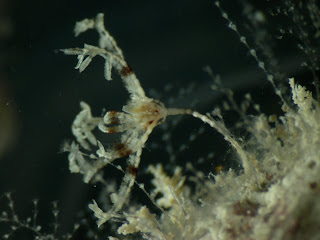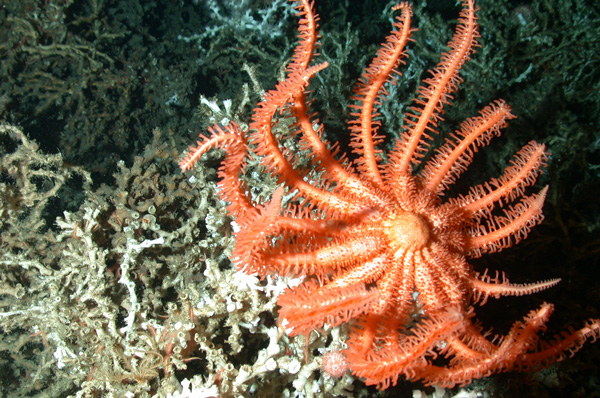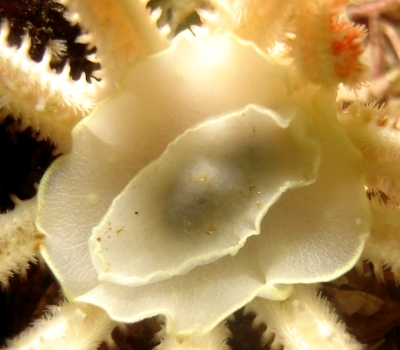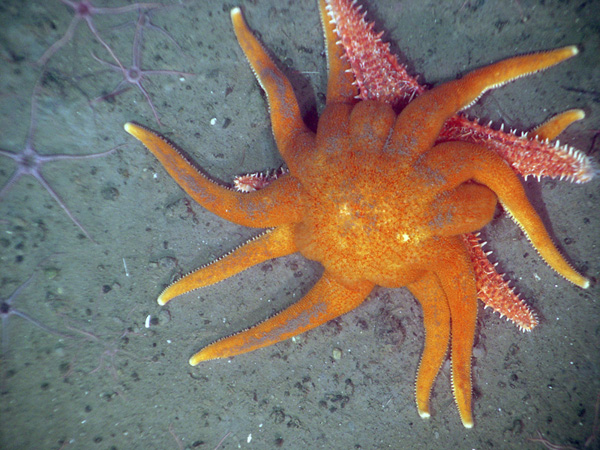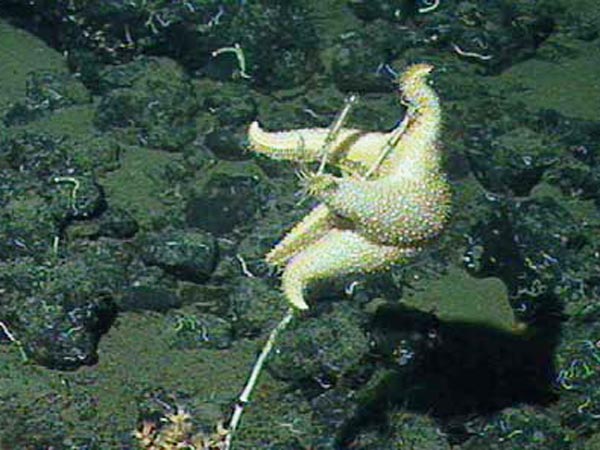The YouTube Echinoblog Video Playlist!! Ophiuroids & Brittle stars!
I've been slowly gathering these up over the last few weeks...and there will be more...but because we've been looking at ophiuroids this week...I thought it would be cool to introduce it here!! I hope to have one for each living echinoderm group along with some other miscellaneous ones....
Enjoy!
Echinodermata! Starfish! Sea Urchins! Sea Cucumbers! Stone Lillies! Feather Stars! Blastozoans! Sea Daisies! Marine invertebrates found throughout the world's oceans with a rich and ancient fossil legacy. Their biology and evolution includes a wide range of crazy and wonderful things. Let me share those things with YOU!
Thursday, April 30, 2009
Monday, April 27, 2009
The World's BIGGEST Brittle Stars!!!
 Let's Survey the World's BIGGEST BRITTLE STARS !!!!! The Echinoblog is ALL about enormous ophiuroids this week!
Let's Survey the World's BIGGEST BRITTLE STARS !!!!! The Echinoblog is ALL about enormous ophiuroids this week! I did one on gigantic starfish a little while back-Click here to go see!!
Let's GO!
1. The Gorgonocephalidae: The Basket Stars (incl. Gorgonocephalus spp.)
A family with arms that branch and branch and branch....until they form a huge "basket" with which they use for suspension feeding (see video above). The Gorgonocephalidae is a pretty big family (with some 55+ genera) distributed around the world.
Gorgonocephalus photo essay here.
Some basket stars, such as Gorgonocephalus have arms that will reach almost 2 to 3 feet across! Not all of them are this big but a lot of them are pretty sizeable....

2. Ophiopsammus maculata (New Zealand)
A member of the Ophiodermatidae, which are usually pretty small tropical beasts..but this one gets pretty big!
A disk that is about 2-3 inches across with an impressive arm span of over 6 to 7 inches!!
Its unclear how they feed but some suspect that they do something very similar to this!


3. Astrostoma agassizi (Antarctic: Southern Ocean)
Okay, so, I'm cheating. Because Astrostoma agasszi IS a member of the Gorgonocephalidae (see above).
I will probably write this up in more detail later but here's some quick details at this site:
Astrotoma is BIG. Disk is easily 2-3 inches across with correspondingly thick arms.


They live in the Southern Ocean/Antarctica in relatively deep-water (about 90-1500m) and feed on crustaceans and other various prey using their very long arms!
 (this image from the Underwater Field Guide to Antarctic Inverts!)
(this image from the Underwater Field Guide to Antarctic Inverts!)5. Ophiocoma aethiops (Baja California/Mexico)
All members of the genus Ophiocoma are tropical, shallow-water in all of the world's oceans and all of the species are pretty sizeable.
 But for some reason, Ophiocoma aethiops from tropical East Pacific is just a bit bigger then the others species of Ophiocoma that one sees in the Indo-Pacific. There's more to this beast..but for now..just appreciate the fact that its a BIG one!
But for some reason, Ophiocoma aethiops from tropical East Pacific is just a bit bigger then the others species of Ophiocoma that one sees in the Indo-Pacific. There's more to this beast..but for now..just appreciate the fact that its a BIG one! Honorable Mention: Stegophiura ponderosa
Honorable Mention: Stegophiura ponderosaSo, this is a deep-water species (at least 100-500 m) from off the west coast of North America, Japan, and Russia.
 (from the Khoyatan Marine Lab website)
(from the Khoyatan Marine Lab website)
This animal is pretty big, but doesn't get beyond about 2 inches in diameter?? So how do they qualify??

 Stegophiura ponderosa is thick!!! Maybe about two to three disks thick???
Stegophiura ponderosa is thick!!! Maybe about two to three disks thick??? Unfortunately, very little is known about its biology. What does it do with all that heavy body mass?? Arms that don't really move out of one plane?? What do they eat??
How do we know so little about critters that are this frakkin' big????
Wednesday, April 22, 2009
More on Feather Stars!! How Long Do They Stick Around?
So, we are doing feather stars these week! While researching the post earlier this week I stumbled upon an interesting concept. How long do crinoids stay in the same place???
 (from C. Messing's Crinoid site-damn, he has good stuff there-you should go take a look at it!)
(from C. Messing's Crinoid site-damn, he has good stuff there-you should go take a look at it!)
You can often see huge bunches of crinoids sitting on rocks or coral or some other kind of perch.
They sit and taking advantage of water currents as they flow by... Often there are many. Sort of like if you have good cell phone reception.....
But did you know that crinoids actually have what's called "site fidelity"? That means that they will remain on a single perch for a long time!
So how long?
The material for this post is largely derived from a paper by Nerida Wilson (2005, Coral Reefs 24: 99-101)-currently at Scripps, working with Greg Rouse which focused on crinoids in the family Mariametridae, primarily Stephanometra, Lamprometra and Liparometra.
 (Liparometera sp. from the SE museum site)
(Liparometera sp. from the SE museum site)
 (from C. Messing's Crinoid site-damn, he has good stuff there-you should go take a look at it!)
(from C. Messing's Crinoid site-damn, he has good stuff there-you should go take a look at it!)You can often see huge bunches of crinoids sitting on rocks or coral or some other kind of perch.
They sit and taking advantage of water currents as they flow by... Often there are many. Sort of like if you have good cell phone reception.....
But did you know that crinoids actually have what's called "site fidelity"? That means that they will remain on a single perch for a long time!
So how long?
 (Liparometera sp. from the SE museum site)
(Liparometera sp. from the SE museum site)It turns out that crinoids will stay in the same place for A LONG TIME (although some may not come out until the sun goes down).
- Some are known to stay in the same place for up to TWO years!!!
- One account actually reported a crinoid that stayed in the same "residence" for FIVE years!!
- Some observations series have continued for over SIX MONTHS with no apparent change!
Wilson observed 13 mariametrid crinoids on a total of 11 perches. There were some individuals that "left" and returned but on the whole...
She observed over the 59 day period that 80% of the crinoids continued to occupy their original perches!
Big feeding clusters like this one have interesting dynamics. Its thought that these big bunches may improve feeding efficiency by slowing down water currents. Big individuals tend to be solitary whereas a bunch of smaller ones will aggregate.
But apparently, there IS competition among individuals for a specific perch with a "winner" forcing the "loser" from the most ideal perch.
So, what have we learned? Crinoids apparently stay in a SINGLE place and they will work to stay there.
Wow. Who'd a thot something so innocuous what have so much depth?
But apparently, there IS competition among individuals for a specific perch with a "winner" forcing the "loser" from the most ideal perch.
So, what have we learned? Crinoids apparently stay in a SINGLE place and they will work to stay there.
Wow. Who'd a thot something so innocuous what have so much depth?
Monday, April 20, 2009
The Secret Lives of Feather Stars REVEALED!!
Today..the SECRET LIVES of FEATHER STARS! (HINT: wait for the twist at the end!)
In many ways, feather stars (aka crinoids-owing to their membership in the Class Crinoidea) are among the most mysterious of echinoderms. We know them as fairly stationary flower-like animals that feed passively as water currents flow by them...
They don't really pursue prey and they seem pretty quiet and keep to themselves, even for echinoderms.
Are they even animals? Even starfish and sea urchins kind of move around and do stuff. What sort of stuff do crinoids do??
Some can maybe capture bigger prey...
and some stalked crinoids are in a game of cat and mouse with predatory sea urchins! (usually as the mouse!)
A recent conference and exchange with researcher Greg Rouse at Scripps Institute of Oceanography reminded me of the SECRET, SECRET lives of feather stars (=unstalked crinoids or just "crinoids" from here on in...) [note-SECRET details herein are from Haig & Rouse 2008)
First, some basics. You got your adults and they produce your eggs and sperm. You get your gametes together and pow! You got them together to form a doliolaria larvae!!
 (Helpful educational diagrams created by the Echinoblog Art Department!!)
(Helpful educational diagrams created by the Echinoblog Art Department!!)
A doliolaria larvae looks something like this:
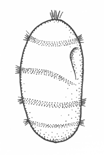
So what happens after that?? Pictured here is a series of what happens!!! The doliolaria settles and begins to TRANSFORM!!! Into this sort of weird transition before it becomes a weird protolarvae called a cystidean larvae!!
 Here, we have ACTUAL photos of an Australian crinoid-Aporometra wilsoni showing various transitionary larval stages:
Here, we have ACTUAL photos of an Australian crinoid-Aporometra wilsoni showing various transitionary larval stages: (From Fig. 2, of Haig & Rouse 2008-courtesy of the authors!)
(From Fig. 2, of Haig & Rouse 2008-courtesy of the authors!)
The three pea-shaped thingies in the top upper left-hand side are doliolaria as the larvae slowly changes into a cystidean larvae. (Development is clockwise youngest to oldest from left to right)
 (From Fig. 2, of Haig & Rouse 2008-courtesy of the authors!)
(From Fig. 2, of Haig & Rouse 2008-courtesy of the authors!)Then...VOILA you have a CYSTIDEAN larvae!!
But WAIT!! The cystidean larvae doesn't look at all like the weird feathery thing we started with....
 It looks more like this: a STALKED crinoid!!!
It looks more like this: a STALKED crinoid!!!
To recap: TWO KINDS of crinoids are alive today.
"Unstalked" crinoids are those which are basically a skeletal cup with a bunch of arms, sometimes with little "legs" called cirri. The great majority of crinoids alive today...especially in tropical shallow-water or in many cold-water settings are unstalked or "comatulid" crinoids.
"Unstalked" crinoids are those which are basically a skeletal cup with a bunch of arms, sometimes with little "legs" called cirri. The great majority of crinoids alive today...especially in tropical shallow-water or in many cold-water settings are unstalked or "comatulid" crinoids.
BUT.....
There exists a much older crinoid body form known as the STALKED crinoids which are seen primarily in the Paleozoic fossil record and today live in the minority in largely deep-sea environments.
Keep that in mind...and let's get back to the story...
Keep that in mind...and let's get back to the story...
As the cystidean larvae gets larger it actually starts to develop a base, a stalk and a feeding cup...
 But THEN, the as the larvae grows, the TOP cup part??? It starts to form little cirri/legs and as it gets bigger and bigger...the cystidean starts to look more like a little tiny stalked crinoid.
But THEN, the as the larvae grows, the TOP cup part??? It starts to form little cirri/legs and as it gets bigger and bigger...the cystidean starts to look more like a little tiny stalked crinoid.
Once the feeding arms and etc. have become fully formed..it reaches what's called the pentacrinoid stage.
The top, cup segment of the pentacrinoid stage develops until this happens:
 But THEN, the as the larvae grows, the TOP cup part??? It starts to form little cirri/legs and as it gets bigger and bigger...the cystidean starts to look more like a little tiny stalked crinoid.
But THEN, the as the larvae grows, the TOP cup part??? It starts to form little cirri/legs and as it gets bigger and bigger...the cystidean starts to look more like a little tiny stalked crinoid. Once the feeding arms and etc. have become fully formed..it reaches what's called the pentacrinoid stage.
The top, cup segment of the pentacrinoid stage develops until this happens:

(note that in the real world the crinoid pentacrinoid stage does not go "BOOM!")
The little cup matures and BOOM!! It separates from the stalk!! and the "cup" is what we see as the adult stage of the "unstalked" crinoids!!
 Neat, eh?
Neat, eh?
And on top of that is an important evolutionary lesson. "Unstalked" crinoids are DESCENDED from Stalked crinoids!!
We see the ancestry of these animals in their life cycle!!The thing with crinoids? the lessons are subtle but VERY rewarding!
(special thanks to Jodie Haig & Greg Rouse for the images!)
Monday, April 13, 2009
The NMNH US Antarctic Research Program Page is OPEN!
This has been an ambitious project to catalog ALL of the Antarctic and subAntarctic marine invertebrates (including but not limited to corals, jellies, worms, crustaceans, mollusks, and of course...echinoderms!) which have been collected under the auspices of the USARP since 1963 and housed in Washington DC in the collections at National Museum of Natural History! This project is of course, supported by the NMNH and the National Science Foundation!!

I have written up how I have worked with the USARP in order to get the specimens and this website up and running (link here).
and mentioned some neat pictures and a site that features the people involved wth USARP!
Their website has a bunch of cool features! For example...let's take a look at the deep-sea molpadid sea cucumber Molpadia musculus!!
1. Specimen Photos!
You get an expert photo for some of the available specimens!
 (NMNH specimen USNM E33281.341505)
(NMNH specimen USNM E33281.341505)
2. DATA!!
You also get a summary of all the NMNH holdings of that particular Antarctic or subAntarctic species!!

What's even MORE cool???? You can get this information MAPPED onto a display of the Antarctic area and classified by depth range!!!!
 And of course, what good would it be if it didn't come cross-referenced with a taxonomic scheme and basic classification information???
And of course, what good would it be if it didn't come cross-referenced with a taxonomic scheme and basic classification information???The citation:
Lemaitre, R., M. G. Harasewych, and J. Hammock (Editors). 2009. ANTIZ v 1.0: A Database of Antarctic and Subantarctic Marine Invertebrates. National Museum of Natural History, Smithsonian Institution. World Wide Web electronic publication. URL http://invertebrates.si.edu/ANTIZ
The Echinoblog Easter Special!!
I am featured in the new Smithsonian Magazine Blog!!!
(and to everyone who knows better-yes, I know its a brittle star and not a starfish. But its such a great picture!)
Woohoo!
(and to everyone who knows better-yes, I know its a brittle star and not a starfish. But its such a great picture!)
Woohoo!
Monday, April 6, 2009
Starfish Feeding!!: When Starfish Capture MOVING Prey!
Well, one of the big shocks to most people is when I tell them that many species of the ever-humble sea star don't just settle for frakkin' mussels and clams..they actually GOES for the big, moving prey! shrimps, fishes and..?????
The"Cryptic" Predator
In New Zealand there lives this weird thing called Stegnaster inflatus (Asterinidae)
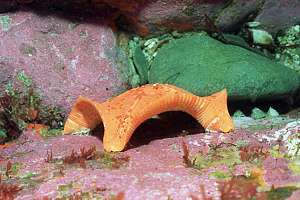 |
| (image from Seafriends.org in New Zealand) |
For a starfish, Stegnaster has a really odd feeding mode. It sits up on its tippy toes as seen above and pretends to be a cave or some other crevice.
 |
| (From Michel Jangoux's Echinoderm Nutrition) |
Following the diagram above, once some small prey has situated itself inside the "cave" with the body lifted above on its arm tips (A), followed by the star then slowly closing off the edges (C and D) until finally whatever is inside gets trapped and the cardiac stomach drops on the hapless prey (E)!! digesting it alive!!
According to Anthoni's Seafriends page this is effective not only against shrimps and snails, but also seahorses and other small fishes!!!
Active Predators When I say active, I mean, they actually use a specific structure for feeding on and obtaining prey....Many of these species practice some kind of bottom-water column type feeding.
Mainly, these beasts are big, multiarmed forcipulate asteroids...hmm...an interesting trend...
1. Stylasterias forreri
Probably one of the first sea stars to be observed feeding or catching moving prey, this animal gained notoriety quickly as being the "fish eating" starfish.

I suspect that the Styla part of Stylasterias refers to "stylet"alluding to the sharp spines on the body surface.
Try as I might, I could not locate a photo or a picture of Stylasterias actually capturing a fish, so we here at the Echinoblog looked to our Echinoblogical Art Department to delivery a hypothetical rendering of this behavior:
 (note that the fish (aka Sea Kitten) is probably not suffering nearly as much as it appears in the rendering!)
(note that the fish (aka Sea Kitten) is probably not suffering nearly as much as it appears in the rendering!)2. Rathbunaster californicus
 |
| (borrowed from the MBARI website) |
These animals live off the west coast of North America in fairly deep-water (about 100-800 m) and were the among the most recently reported to feed on mobile prey in a cool paper by Lynn Lauerman who observed them with ROVs and had many great opportunities to collect and watch them alive.
These handsome animals were named for Dr. Richard Rathbun, a curator of crustaceans at the Smithsonian National Museum of Natural History. I wonder if Walter K. Fisher (who named the genus and species) realized that they fed on crustaceans when he named the starfish for him!
Although they have opportunistic tendencies (they don't always feed on mobile crustaceans) they do show a very strong propensity for eating things that swim by them..
3. Labidiaster annulatus
 I wrote a fairly involved post about this really neat Antarctic predator here. But short version...it uses its huge and jagged pedicellariae:
I wrote a fairly involved post about this really neat Antarctic predator here. But short version...it uses its huge and jagged pedicellariae: To feed on krill as they go swimming by it. Prey get held fast by these jagged jaws and are dragged down to the mouth where they are eaten alive! Aieee!!
To feed on krill as they go swimming by it. Prey get held fast by these jagged jaws and are dragged down to the mouth where they are eaten alive! Aieee!!4. The Brisingids!
Shown here is Novodinia antillensis from the NOAA explorer site) Taken by S. Brooke.
I wrote a much more involved post about these neat animals here. But, but the short version is that brisingid asteroids are suspension feeders/predators that feed by using pedicellariae all over their arm spines to capture prey as the water current takes food through their arm "feeding basket" providing foodstuffs to be captured on the arm spines.
What (and how) do Starfish EAT??? Part 1
How do Starfish EAT??? And why am I suddenly writing about this???? The other day, an educated but non-professional person wrote something to me that said "All starfish eat mussels".
This was followed by me doing this:
 Then...I regained my composure.
Then...I regained my composure.Okay..so let me say this again. NOT ALL STARFISH EAT MOLLUSKS!!
There seems that YEARS of biology and zoology textbooks using the common nearshore asteriid starfish Asterias and Pisaster and their kin as models of the "common" starfish have led to assumptions and misconceptions about their feeding mode as the basis for ALL starfish.
 STARFISH DO NOT FEED ALIKE. There is a HUGE diversity of feeding modes among asteroids.
STARFISH DO NOT FEED ALIKE. There is a HUGE diversity of feeding modes among asteroids.Let's survey some diversity and break some overgeneralizations shall we???
1. SOME Starfish DON'T use a stomach to feed!
Paxillosidans: including "sand stars" such as Astropecten and/or Luidia will usually SWALLOW their prey whole.
Sometimes they eat OTHER starfish!
Above we have an Atlantic Luidia feeding on a much less fortunate Astropecten. Note that there is NO STOMACH extruded. The prey is simply being EATEN ALIVE and swallowed into the mouth!
Sometimes they overdo it (here to see more of this)....here is Luidia superba having just gouged itself on a sand dolar...
![[Lsuperba1.jpg]](https://blogger.googleusercontent.com/img/b/R29vZ2xl/AVvXsEiKeqZWWj5QE5n7cmDIk8QVUyLgk8Thj8xhp-01WTK6VBhllH8jOm9S5jx589fYW1kJYLk9DEgblD5xrH7lIBBNcf7PfevOGTFwI25-9BTAOx_WAxAgoEzGPykCHBtwtp5SbMWR-5X_vNU/s1600/Lsuperba1.jpg)
...and others SWALLOW mud and the foodish bits that are found in deep-sea mud and sediment! No eversible stomachs here.
 Many deep-sea (these live at 3000+m !!) porcellanasterid "mud stars" are collected with their guts FILLED with mud.
Many deep-sea (these live at 3000+m !!) porcellanasterid "mud stars" are collected with their guts FILLED with mud.To the point that the animals are literally BALLS of mud surrounded by starfish stuff!! The thickness you see in this deep-sea Styracaster sp?? ALL MUD!!!
 2. And then, we get to those starfish that DO feed using their extendable stomachs!
2. And then, we get to those starfish that DO feed using their extendable stomachs!Many, such as the tropical sea star Protoreaster gain most of their nutrition from microalgae and don't really feed much on meaty bits (which is probably why they don't live long if you feed them clam meat)
 and this Patiria miniata extend their stomachs in order to feed on small microalgae or opportunistically ANY small food they can roll their stomach over and eat!! Usually starfish species that feed in this way can also feed on encrusting animals like sponges, bryozoans, and etc...
and this Patiria miniata extend their stomachs in order to feed on small microalgae or opportunistically ANY small food they can roll their stomach over and eat!! Usually starfish species that feed in this way can also feed on encrusting animals like sponges, bryozoans, and etc... This feeding mode is actually pretty common.
This feeding mode is actually pretty common. If I could make ANY generalization about starfish feeding, it is that many species are OMNIVOROUS. That is, they can feed on just about anything slower then them..algae, encrusting invertebrates, etc. But really, they don't always feed on other moving animals
...and finally we get to the starfish that FEED on bivalve mollusks. Many of these are taxa that are restricted to the ASTERIIDAE. and EVEN these starfish don't always feed on bivalves...sometimes its snails or what have you... To be honest, there's a fair number of asteriid species that feed this way..but
- Its a specialized feeding mode (the humped posture over the shell)
- The great majority of taxa aren't asteriid starfish and DON'T feed this way.
 So, what ELSE do starfish EAT (i.e., prey on vs. just opportunistically feed on)? (this is just a survey of prey items..and NOT a complete listing!)
So, what ELSE do starfish EAT (i.e., prey on vs. just opportunistically feed on)? (this is just a survey of prey items..and NOT a complete listing!)NUDIBRANCHS! (Cadlina luteomarignata being fed upon by Crossaster papposus-contrary to what the original source says)
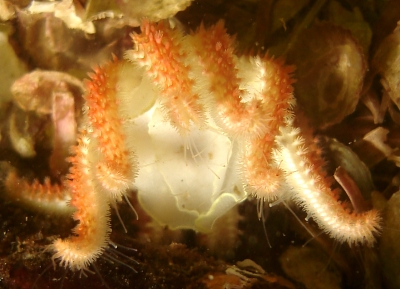
...and of course...coral!! Both deep-sea (Hippasteria/Evoplosoma on ???)
(from the NOAA Ocean Explorer page)
and shallow-water coral! (the crown-of-thorns Acanthaster planci on "stony" corals)From here we go onto STARFISH THAT Can Capture MOBILE (Swimming) FOOD!!!
Subscribe to:
Posts (Atom)


